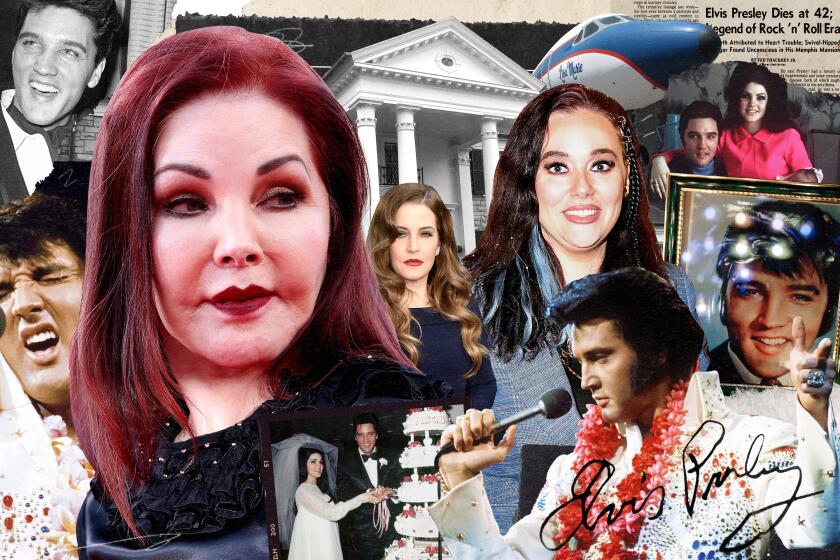Jeff Koons outdoor sculpture ‘Split-Rocker’ will anchor LACMA’s new building

- Share via
A new acquisition has bloomed at the Los Angeles County Museum of Art, which is expected to announce Monday that Jeff Koons’ monumental topiary sculpture “Split-Rocker” will anchor the east side of the campus at the new David Geffen Galleries building.
The 37-foot-tall living sculpture, created in 2000, is designed to nurture more than 50,000 flowering plants and will be seeded in August with the hope that it will be fully established by April, when architect Peter Zumthor’s new poured concrete building is scheduled to open to the public.
“I couldn’t be more thrilled than to have a piece of floral work in Los Angeles where — horticulturally — there’s such a wide variety of plants that can be used in its creation,” Koons said in a phone interview from his New York studio. “I hope people going back and forth on Wilshire Boulevard, and people visiting the museum, are able to enjoy and experience the change in the piece.”
ICE protests downtown had a powerful backdrop: the 1990 Barbara Kruger mural ‘Questions,’ which interrogates the very nature of power and control.
The acquisition and continued maintenance of “Split-Rocker” was paid for by the foundation of longtime LACMA donors and Koons supporters Lynda and Stewart Resnick. It’s been in the works for years, during which time LACMA and Koons consulted with a team of area horticulturalists who zeroed in on which plants would thrive during which times of year.
Koons said he’s excited to use native succulents and drought-tolerant plants as well as perennials and annuals that will provide a richness of color. The sculpture features two toy rockers— a horse and a dinosaur — that are split in half and paired unevenly down the middle for an angular Cubist effect. It’s made of steel armatures and outfitted with an internal irrigation system.
“Split-Rocker” will be the first outdoor work of art guests will see driving west on Wilshire from downtown. It will sit across the street from the La Brea Tar Pits’ tragic woolly mammoth family, adding a playful bit of fantasy architecture to LACMA’s 3.5-acre park space.
The Lucas Museum of Narrative Art has riveted the public with its futuristic architecture. But the lasting impact of George Lucas’ billion-dollar museum may lie in its landscape.
The sculpture will join the museum’s other highly recognizable works of public art, including Chris Burden’s “Urban Light” and Michael Heizer’s “Levitated Mass,” as well as a newly commissioned children’s garden sculpture of a whimsical UFO by Shio Kusaka and Mariana Castillo Deball’s “Feathered Changes,” which stretches over three football fields of raked, carved and imprinted concrete composing the museum’s plaza.
LACMA is also reinstalling Alexander Calder’s monumental “Three Quintains,” which was commissioned for the then-new museum complex in 1965. Tony Smith’s massive “Smoke” sculpture already has been installed.
“From the day I landed, I obviously knew I wanted to focus on L.A. artists,” said LACMA Chief Executive and Director Michael Govan. “But then I wanted to just bring a little New York too.”
“Split-Rocker,” like Koons’ only other topiary sculpture, “Puppy” from 1992, was created as an edition of one, plus one artist proof. LACMA has acquired the artist proof, which in 2014 towered over visitors to Rockefeller Center in Manhattan. Edition 1 of “Split-Rocker” is currently installed at Glenstone, a museum in Potomac, Md. The artist proof of “Puppy” famously greets visitors to the Guggenheim Museum in Bilbao, Spain. Edition 1 is at the Brant Foundation in Greenwich, Conn.

“Out of those four cities, L.A. is the only place where there’s good weather all year round, and it doesn’t have to go to sleep in the winter,” Govan said of “Split-Rocker,” noting how excited he is to see it change with the seasons.
The idea for “Split-Rocker” came to Koons when he noticed his son’s rocking horse in one corner of a room, and a rocking dinosaur in another.
“And I thought, oh my gosh, if you would just split those two down the center and then put their two profiles together, it would be kind of like a Picasso piece,” Koons said. “Because the one eye of the dino would be looking one way, and the eye of the pony would be looking completely in a different direction, and their profiles would not line up perfectly.”
When Koons began creating color schemes for the piece, he divided it into five different shading groups, with the dinosaur imbued with a different color range than the pony.
“When you plant it, you try to take control, and you’re able to put certain colors and certain plants in certain areas,” Koons said. “But at a certain point you have to walk away, and it’s in the hands of nature.”
Govan said he believes in the power of public sculpture and hopes “Split-Rocker” and the other monumental works on the LACMA campus will serve as beacons to passersby, beckoning them to explore further inside. They also are powerful tools of social media marketing, as guests photograph themselves and essentially promote a visit. One of Govan’s earliest memories, he said, is visiting his grandparents in Chicago and seeing the Picasso in Daley Plaza out the car window.
“It was was one of my first entry points to art, and art in public, as a very young person, and I never let it go,” Govan said. “Kids should see something on the street that’s art — not a building — that makes them want to get out and go back.”
More to Read
The biggest entertainment stories
Get our big stories about Hollywood, film, television, music, arts, culture and more right in your inbox as soon as they publish.
You may occasionally receive promotional content from the Los Angeles Times.













